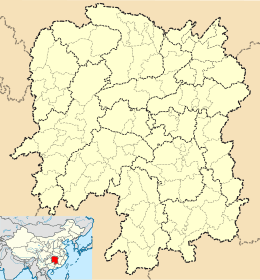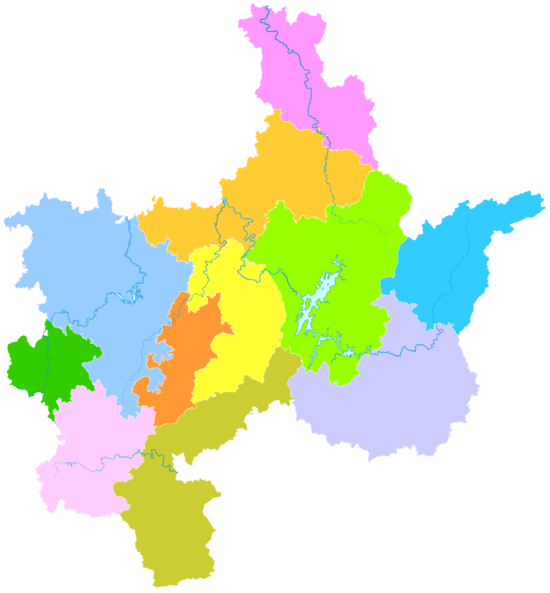Chenzhou
Chenzhou (Chinese: 郴州; pinyin: Chēnzhōu) is a prefecture-level city located in the south of Hunan province, China, bordering the provinces of Jiangxi to the east and Guangdong to the south. Its administrative area covers 19,317 square kilometres (7,458 sq mi), 9.2% of the provincial area, and its total population reached 4,559,600 in 2001, 26% of them living in urban areas, 74% of them live in rural areas.[2]
Chenzhou 郴州市 | |
|---|---|
 Chen River and the residential on the river bank in Chenzhou City | |
.png) Chenzhou's administrative area in Hunan | |
 Chenzhou Location of the city center in Hunan | |
| Coordinates (Chenzhou municipal government): 25°46′12″N 113°00′58″E | |
| Country | People's Republic of China |
| Province | Hunan |
| Municipal seat | Beihu District |
| Area | |
| • Prefecture-level city | 19,317 km2 (7,458 sq mi) |
| • Urban (2017)[1] | 580.00 km2 (223.94 sq mi) |
| Population (2001) | |
| • Prefecture-level city | 4,559,600 |
| • Density | 240/km2 (610/sq mi) |
| • Urban (2017)[1] | 638,400 |
| Time zone | UTC+8 (China Standard) |
| Postal code | 423000 |
| Area code(s) | 0735 |
| ISO 3166 code | CN-HN-10 |
| License plate prefixes | 湘L |
| GDP(2015) | CNY 201.21 billion |
| Website | en |
History
In 1928, according to the biography of Mao Zedong by Jung Chang and Jon Halliday, Chenzhou, along with neighboring Leiyang was razed by troops under the command of Zhu De, who was following directives which originated in Moscow and passed on by higher officials of the Communist Party of China. The strategy was to leave large numbers of peasants with no option but to join communist uprisings.
Chenzhou was the site of a large investigation when its municipal government and party committee, led by Secretary Li Dalun, was charged on multiple counts of corruption in June 2006.
Geography
Chenzhou is situated at the juncture of Hunan and Guangdong provinces at the foot of Qitianling Hill of the Nanling Mountain Range. Places of interest, natural scenic spots, ancient relics and buildings make for over 100 tourism spots in the city. The major ones are the Suxian Hill, the Wanhuayan, the Dongjiang Lake, and the Wugai Mountain Hunting Field.
Climate
Chenzhou has a humid subtropical climate (Köppen climate classification: Cfa), with four distinct seasons. Spring is subject to heavy rainfall, while the summers are long, hot, and humid with lesser rainfall, and autumn is comfortable and rather dry. Winter is rather brief, but cold snaps occur with temperatures occasionally dropping below freezing, and while not heavy, rain can be frequent.
| Climate data for Chenzhou (1981−2010) | |||||||||||||
|---|---|---|---|---|---|---|---|---|---|---|---|---|---|
| Month | Jan | Feb | Mar | Apr | May | Jun | Jul | Aug | Sep | Oct | Nov | Dec | Year |
| Record high °C (°F) | 27.0 (80.6) |
31.5 (88.7) |
33.7 (92.7) |
35.6 (96.1) |
35.9 (96.6) |
38.0 (100.4) |
40.3 (104.5) |
40.5 (104.9) |
38.6 (101.5) |
36.3 (97.3) |
33.5 (92.3) |
27.4 (81.3) |
40.5 (104.9) |
| Average high °C (°F) | 10.3 (50.5) |
12.4 (54.3) |
16.7 (62.1) |
23.3 (73.9) |
27.8 (82.0) |
31.1 (88.0) |
34.4 (93.9) |
33.2 (91.8) |
29.1 (84.4) |
24.1 (75.4) |
18.8 (65.8) |
13.4 (56.1) |
22.9 (73.2) |
| Daily mean °C (°F) | 6.4 (43.5) |
8.6 (47.5) |
12.6 (54.7) |
18.7 (65.7) |
23.3 (73.9) |
26.8 (80.2) |
29.6 (85.3) |
28.3 (82.9) |
24.6 (76.3) |
19.4 (66.9) |
13.9 (57.0) |
8.5 (47.3) |
18.4 (65.1) |
| Average low °C (°F) | 3.8 (38.8) |
6.0 (42.8) |
9.6 (49.3) |
15.4 (59.7) |
19.8 (67.6) |
23.5 (74.3) |
26.0 (78.8) |
24.8 (76.6) |
21.3 (70.3) |
16.0 (60.8) |
10.4 (50.7) |
5.1 (41.2) |
15.1 (59.2) |
| Record low °C (°F) | −4.3 (24.3) |
−3.6 (25.5) |
−1.9 (28.6) |
2.9 (37.2) |
10.0 (50.0) |
13.4 (56.1) |
18.6 (65.5) |
18.3 (64.9) |
13.2 (55.8) |
4.2 (39.6) |
−1.6 (29.1) |
−6.3 (20.7) |
−6.3 (20.7) |
| Average precipitation mm (inches) | 80.1 (3.15) |
116.2 (4.57) |
155.4 (6.12) |
190.3 (7.49) |
186.6 (7.35) |
191.9 (7.56) |
123.0 (4.84) |
170.6 (6.72) |
96.1 (3.78) |
77.5 (3.05) |
67.9 (2.67) |
47.9 (1.89) |
1,503.5 (59.19) |
| Average precipitation days (≥ 0.1 mm) | 17.1 | 16.8 | 19.9 | 18.5 | 18.3 | 15.5 | 11.3 | 14.0 | 12.2 | 13.5 | 11.6 | 10.4 | 179.1 |
| Average relative humidity (%) | 82 | 82 | 81 | 79 | 77 | 75 | 67 | 73 | 77 | 78 | 77 | 77 | 77 |
| Source 1: China Meteorological Data Service Center[3] | |||||||||||||
| Source 2: Weather China (precipitation days 1971-2000) | |||||||||||||
Administrative divisions

- Beihu District (北湖区), 815 km2 (315 sq mi). Population: 300,000 (2003).
- Suxian District (苏仙区), 1,342 km2 (518 sq mi). Population: 249,900
- Zixing City (资兴市) 2,716 km2 (1,049 sq mi). Population: 360,000
- Guiyang County (桂阳县), 2,954 km2 (1,141 sq mi). Population: 790,000
- Yongxing County (永兴县), 1,979 km2 (764 sq mi). Population: 630,000
- Yizhang County (宜章县), 2,086 km2 (805 sq mi). Population: 560,000
- Jiahe County (嘉禾县), 696 km2 (269 sq mi). Population: 340,000
- Linwu County (临武县), 1,375 km2 (531 sq mi). Population: 310,000
- Rucheng County (汝城县), 2,424 km2 (936 sq mi). Population: 360,000
- Guidong County (桂东县), 1,453 km2 (561 sq mi). Population: 170,000
- Anren County (安仁县), 1,461 km2 (564 sq mi). Population: 390,000
| Map |
|---|
Economy
Major deposits of tungsten, bismuth and molybdenum make Chenzhou a production base for non-ferrous metals.
Notable people
- Duan Yixuan, a singer and actress
- Long Yang, a hostess in CCTV
- Ouyang Jingling, a paralympic athlete
Government
The current CPC Party Secretary of Chenzhou is Yi Pengfei and the current Mayor is Liu Zhiren.
Tourism
The areas of interest in Chenzhou include: Wanhua Rock (万华岩), Wugai Mountain Hunting Field, Suxian Hill and Dongjiang Lake.
References
- Ministry of Housing and Urban-Rural Development, ed. (2019). China Urban Construction Statistical Yearbook 2017. Beijing: China Statistics Press. p. 68. Retrieved 11 January 2020.
- (in Chinese) Demographics of Chenzhou Archived May 11, 2008, at the Wayback Machine, Official website of Chenzhou Government, August 28, 2007.
- 中国地面气候标准值月值(1981-2010) (in Chinese). China Meteorological Data Service Center. Retrieved 20 October 2018.
External links
- Chenzhou News Website, run by Chenzhou Government
- Official website of Chenzhou Government
